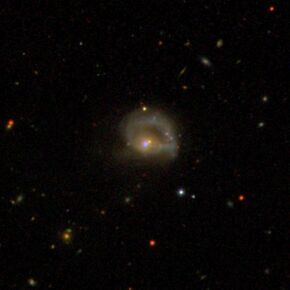NGC 985
Topic: Astronomy
 From HandWiki - Reading time: 3 min
From HandWiki - Reading time: 3 min
| NGC 985 | |
|---|---|
 NGC 985 by the SDSS | |
| Observation data (J2000 epoch) | |
| Constellation | Cetus |
| Right ascension | 02h 34m 37.8s[1] |
| Declination | −08° 47′ 15″[1] |
| Redshift | 0.043143 ± 0.000073 [1] |
| Helio radial velocity | 12,934 ± 22 km/s[1] |
| Distance | 567 Mly (174 Mpc)[1] |
| Apparent magnitude (V) | 13.5 |
| Characteristics | |
| Type | Ring pec [1] |
| Apparent size (V) | 1.0′ × 0.9′[1] |
| Notable features | Seyfert galaxy |
| Other designations | |
| VV 285, Mrk 1048, MCG -02-07-035, PGC 9817[1] | |
NGC 985 is a ring galaxy in the constellation of Cetus. It is located about 550 million light years away from Earth, which means, given its apparent dimensions, that NGC 985 is approximately 160,000 light years across. It was discovered by Francis Leavenworth in 1886.[2] It is a type 1 Seyfert galaxy.[3]
NGC 985 is characterised by its ring shape. It is believed it was formed as a result of a galaxy merger. Further evidence supporting this theory is the observation of a second nucleus in NGC 985.[4] When observed in infrared light, a second nucleus was found 3.8 arcseconds northwest of the active nucleus. It is much redder than the rest of the galaxy, indicating the presence of old stars. It has been suggested that the collision between a disk galaxy with another galaxy caused the formation of the ring and displaced the nucleus of the galaxy, creating an empty ring. Based on the kinematics of the galaxy, the secondary nucleus belonged to the intruder galaxy, while the active nucleus is associated with the main stellar component.[5][6]
As is common with merger remnants, NGC 985 has increased star formation rate, and as a result shines bright in the infrared. The total infrared luminosity of NGC 985 is 1.8×1011 L☉ and it is characterised as a luminous infrared galaxy. The total molecular gas mass of the galaxy is estimated to be 2×1010 M☉. Very large molecular clouds exist near the nuclei. They may be clouds gathering around the nucleus in the process of forming a disk around the two nuclei or molecular clouds disrupted by an outflow from the nucleus of the galaxy.[7]
NGC 985 is a powerful X-ray source, detected by ROSAT. It is a complex X-ray source, whose spectrum cannot be accounted for by a simple power law at 0.6 keV and suggests the presence of a warm absorber.[8] The hard X-ray emission on the other hand is characterised by a simple power law.[9] The X-ray flux, especially soft X-rays, diminished in NGC 985 in 2013. The variability of the X-ray and ultraviolet emission from the nucleus was observed using the XMM-Newton and Hubble Space Telescope respectively. These observations revealed the presence of outflowing wind from an accretion disk formed around a supermassive black hole that obstructed the nucleus in soft X-rays and UV. The nucleus is otherwise seen unobstructed.[10]
References
- ↑ 1.0 1.1 1.2 1.3 1.4 1.5 1.6 1.7 "NASA/IPAC Extragalactic Database". Results for NGC 985. http://ned.ipac.caltech.edu/cgi-bin/nph-objsearch?objname=NGC+985.
- ↑ Seligman, Courtney. "NGC 985 (= PGC 9817)". http://cseligman.com/text/atlas/ngc9a.htm#985.
- ↑ Doi, Akihiro; Inoue, Yoshiyuki (1 August 2016). "High-frequency excess in the radio continuum spectrum of the type-1 Seyfert galaxy NGC 985". Publications of the Astronomical Society of Japan 68 (4): 56. doi:10.1093/pasj/psw052. Bibcode: 2016PASJ...68...56D.
- ↑ Appleton, P. N.; Marcum, P. M. (November 1993). "Infrared Observations of the Seyfert Ring Galaxy NGC 985". The Astrophysical Journal 417: 90. doi:10.1086/173293. Bibcode: 1993ApJ...417...90A.
- ↑ Garcia, A. M. Perez; Espinosa, J. M. Rodriguez (November 1996). "A Companion Nuclear Bulge to the Seyfert Ring Galaxy NGC 985". The Astronomical Journal 112: 1863. doi:10.1086/118147. Bibcode: 1996AJ....112.1863P.
- ↑ Arribas, S.; Mediavilla, E.; del Burgo, C.; Garcia-Lorenzo, B. (February 1999). "Two-dimensional Spectroscopy in the Circumnuclear Region of the Seyfert 1 Ring Galaxy NGC 985". The Astrophysical Journal 511 (2): 680–685. doi:10.1086/306706. Bibcode: 1999ApJ...511..680A.
- ↑ Appleton, P. N.; Charmandaris, V.; Gao, Yu; Combes, F.; Ghigo, F.; Horellou, C.; Mirabel, I. F. (20 February 2002). "Mid-Infrared and CO Observations of the Infrared/X-Ray Luminous Seyfert 1 Galaxy NGC 985: The Making or Breaking of a ULIRG?". The Astrophysical Journal 566 (2): 682–698. doi:10.1086/338227. Bibcode: 2002ApJ...566..682A.
- ↑ Brandt, W. N.; Fabian, A. C.; Nandra, K.; Reynolds, C. S.; Brinkmann, W. (15 December 1994). "ROSAT PSPC observations of the Seyfert 1 galaxies Ark 564, NGC 985, Kaz 163, Mrk 79 and RX J2256.6+0525". Monthly Notices of the Royal Astronomical Society 271 (4): 958–966. doi:10.1093/mnras/271.4.958. Bibcode: 1994MNRAS.271..958B.
- ↑ Risaliti, G.; Gilli, R.; Maiolino, R.; Salvati, M. (1 May 2000). "The hard X-ray emission of luminous infrared galaxies". Astronomy and Astrophysics 357: 13–23. ISSN 0004-6361. Bibcode: 2000A&A...357...13R.
- ↑ Ebrero, J.; Kriss, G. A.; Kaastra, J. S.; Ely, J. C. (27 January 2016). "Discovery of a fast, broad, transient outflow in NGC 985". Astronomy & Astrophysics 586: A72. doi:10.1051/0004-6361/201527495. Bibcode: 2016A&A...586A..72E.
External links
- NGC 985 on WikiSky: DSS2, SDSS, GALEX, IRAS, Hydrogen α, X-Ray, Astrophoto, Sky Map, Articles and images
- NGC 985 on SIMBAD
 |
 KSF
KSF